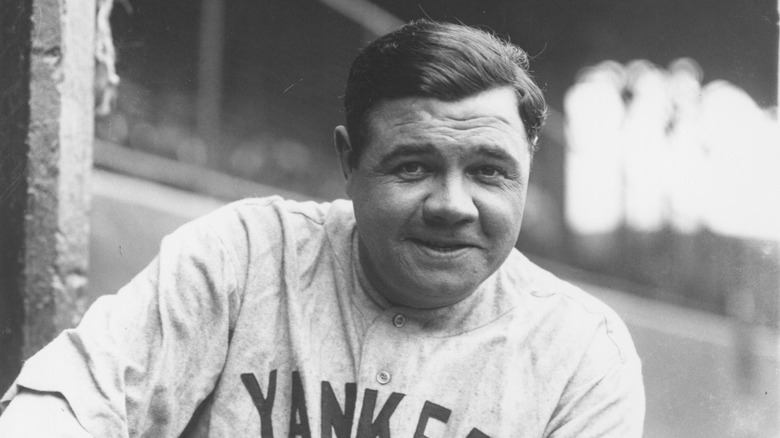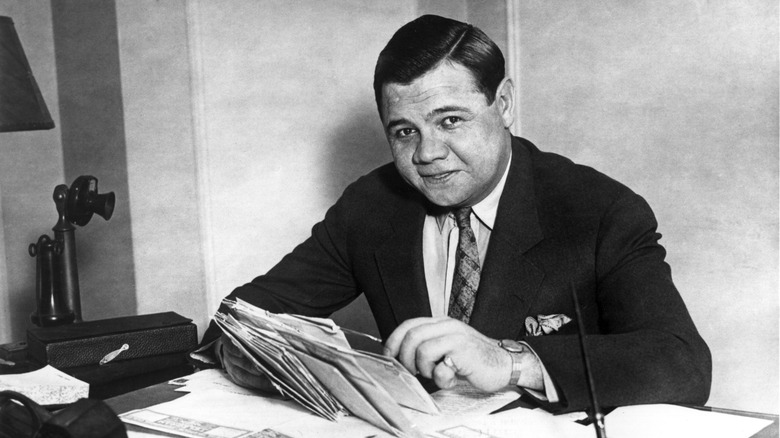The Convoluted Story About How Baby Ruths Got Their Name
Though America has a lot of candy bars, there's only one we know of named after a successful athlete (unless there's a Leon "Milky Way" Roberts from football history that we're not aware of): The Baby Ruth. A mixture of peanuts, caramel, and nougat, Baby Ruth is one of America's oldest candy bars, initially hitting the market back in 1900, though under a different name. Surely, this must have been a case of slugger George Herman "Babe" Ruth marketing a candy bar after his popularity, right?
No, it was not; Ruth never received any money for the Baby Ruth name. How exactly is that possible? It's because the bar's manufacturer offered an official explanation that Baby Ruth is named after Ruth Cleveland, the daughter of former President Grover Cleveland. Ah, mystery solved, then! It's definitely not named after Babe Ruth and appropriating his name or anything; clearly, it's just a huge coincidence!
Or is it? While it can't be proven that Baby Ruth is named after noted baseball hall-of-famer Babe Ruth, there's significant evidence to suggest it was named after him and not the little-remembered deceased daughter of a president from 30 years before the candy bar's creation. The candy's manufacturer may deny it, but let's look at the facts, shall we?
The timing on Baby Ruth's introduction to the market is suspect
Again, it's important to note that absolutely none of this can be stated definitively; the Curtiss Candy Company, the candy bar's original creator (it's now owned by a subsidiary of Ferrero), maintained for decades after it came out with the bar that it was named for Ruth Cleveland, the daughter of Grover Cleveland who died tragically age 12 in 1904. And to be fair, Ruth Cleveland was indeed known as "Baby Ruth;" that part is accurate.
But everything else about Baby Ruth's name throws this explanation into doubt. The candy bar was originally known as Kandy Kake and hit the market in 1900, but in 1921, with a tweaked formula, it was renamed the Baby Ruth. That also happens to be the year after Babe Ruth absolutely shattered the single-season home run record for the first time (it wouldn't be the last) and became the biggest name in sports. It was a massive success as one of the most popular candies in America during the decade. Curtiss later claimed the candy bar hit the market "some years before Babe Ruth, the ballplayer, became famous."
But Ruth was plenty famous in 1921, considering he had just finished rewriting the rules of America's national pastime. The Curtiss Candy Company either didn't realize how time worked or it didn't want to.
Ruth once sued to use his own name -- and lost
The wild thing is that Babe Ruth tried to market his own candy bar using his name, and the Curtiss Candy Company sued to have it taken off the market. In 1926, his company tried to patent "Ruth's Home Run Candy" and release his own chocolate bar. Curtiss was having none of it, suing for copyright infringement, as the name was too close to their product. Somehow, inexplicably, they won.
This doesn't prove the candy bar wasn't named after Ruth Cleveland — but Curtiss's own statements on the matter raise some questions. The company eventually sought to answer why in the world it would name a candy bar after a deceased president's daughter. Still, its explanation is lacking, to say the least. The company claimed Ruth Cleveland had visited its factory as a child, and this caused it to name its flagship candy bar after her nearly two decades later.
It's worth noting that there's absolutely no evidence that Cleveland visited the factory (although there's also no evidence to directly refute it, either). The U.S. legal system apparently just decided to take them at their word. While there's no proof the bar wasn't named after Ruth Cleveland, let's just say there's plenty to cast doubt on the whole story.


